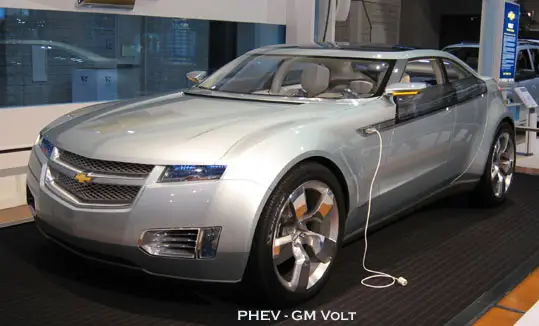Plug in hybrid electric vehicles (PHEVs) are an extension of the hybrid electric(HEV) concept. “The key difference is that they are able to use electricity from the grid to supplement that in their hydrocarbon fuel tanks. They require substantially larger batteries than HEVs, plus more sophisticated controls, i.e. onboard batteries able to store enough electricity to power their host vehicle for from 30 to as much as 100 kilometres or more, of urban-cycle driving without recourse to its internal combustion engine. If the vehicle’s battery charge gets too low, the internal combustion engine automatically cuts in to start recharging as a s powering the vehicle.
Vehicle batteries can be recharged form a standard power point, analogous to recharging a mobile phone or any other portable battery appliance such as power tools. This charging is preferably done overnight when the demand for electricity is at a minimum and the grid has surplus power available at low off-peak rates.
What is appealing to a growing number of electricity utilities, in the USA at least, is the realisation that PHEVs that are parked and plugged into the grid, or even just the basement of an office building, collectively represent a usefully large amount of stored energy that can be accessed to the mutual benefit of the utility, the vehicle owners and the managers of the host building. This logically leads to the concept of PHEVs supplying power in the reverse direction: the concept of Vehicle to Grid (V2G).“ (Energy News, Official Journal of The Australian Institute of Energy, Volume 25 Number 4, December 2007, www.aie.org.au )

Air Quality
Smog in many large cities is an increasing problem, causing problems for human health with ground-level ozone, sulfur dioxide, nitrogen dioxide and carbon monoxide being especially harmful for senior citizens, children, and people with heart and lung conditions. Compared to conventional vehicles, Plug in Hybrid Electric Vehicles can reduce air pollution as they do not emit pollutants when running on the electric side of the system.
However, unless the vehicles are recharged from renewable energy sources, they do shift the pollution from the vehicle tail pipes to the smoke stacks of a power station. Even so, the total quantity of particulate emissions are little lower and perhaps more open to control when emitted from a single point source such as a coal power station. Recharging Plug in Hybrid Electric Vehicles from coal power stations may need to be considered as a transitional stage. As more and more renewable energy comes online the potential to recharge PHEVs from these clean source increases, and in the meantime infrastructure and vehicle stocks can increase.
Greenhouse Gas Emissions
Generally electric vehicles that are recharged from coal fired power stations can claim very little greenhouse gas benefit. Significant reductions in greenhouses gases will only come when Plug in Hybrid Electric Vehicles are recharged from renewable energy sources. Again and as suggested above, we may need to consider a transitional stage, where coal electricity provides recharge-power allowing the PHEV industry to develop commercially.
“…Energy stored in a battery may be utilised far more efficiently to drive a motor vehicle’s wheels than can energy stored as petrol, diesel or LPG in an onboard fuel tank, because electric motors can convert around 90% of the power delivered to them in mechanical energy.
Electric motors also have more favourable torque-speed characteristics because they don’t generate their maximum torque at stall, and they don’t need sophisticated torque converters or even gearboxes. Meanwhile, the varying torque and speed regimes internal combustion engines must meet mean they can rarely operate at their efficiency sweet spot, so their conversion of chemical energy-in-fuel to mechanical energy at-the-wheels is usually just 10-15%. This compares with around 80% battery-to-wheels efficiencies for electric drives. On the other hand, the losses in converting the energy in coal in a mine to electricity stored in a vehicle’s battery are far higher than the losses involved in converting the energy in crude petroleum in an oil field to the energy in petrol or diesel in a motor vehicle’s fuel tank”. (Energy News, Official Journal of The Australian Institute of Energy, Volume 25 Number 4, December 2007, www.aie.org.au )
Have you seen the pages on hydrogen cars, gas wood generators, or converting you own car to electric?
